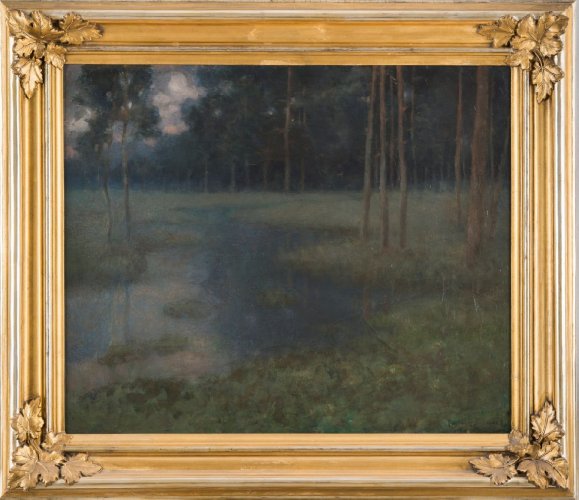Description:
Eugeniusz Dąbrowa-Dąbrowski (1870-1941) was a self-taught man, drawing knowledge and inspiration from numerous travels across Europe and Africa. He never settled in one place for too long, often changing his place of residence. For a few years he was associated with the Polish artistic colony in Munich. In 1901 he became a member of TPSS. He intensely exposed his works at many Polish and European Salons. He was also involved in applied art, graphics, furniture and kilim design, as well as interior decoration.
Description of the painting:
From the title darkness emerges a forest just after a heavy rain, leaving behind a mirror of water spread widely across the forest glade. In the water a faint light penetrates through the crowns of trees. Shapes and colors are blurred and merge with each other to such an extent that almost a palpable moisture and smell of the forest can be felt.
An incredibly dark painting, painted in smudged greens and blues, can be found in the hall of the Rogalinska Gallery among other works of the so-called Munich School. Eugeniusz Dąbrowa-Dąbrowski was self-taught, but for many years was associated with the Polish artistic colony in Munich. This was an environment created thanks to the Munich Academy of Fine Arts, friendly to the Poles, to which numerous artists went to continue their studies previously started in the country. Many of them opened studios there or came for the exhibitions organized in the city.
Over time, a special type of moody painting emerged in this environment. Most often these were romantic landscapes set in the native landscape, depicting forests, fields, rivers and villages, in which a strong nostalgia, but also pride in the beauty of Poland can be read. Landscapes, similarly to “Darkness after the Rain” were realistic, but they also had a lyrical, romantic layer of its own, so-called “Stimmung”. “Darkness after the Rain” does not represent a particular, known fragment of the forest. There are no characteristic points of reference to a real place in the painting. The painter wanted to convey the impression of transience and enclose this moment in the painting. It transports the viewer to the edge of a foggy, dark forest, where the mist rises from the wet grass, blurring shapes. The landscape simultaneously scares and intrigues with its lyrical, romantic layer. The canvas is a perfect example of the “Stimmung” painting of the turn of the 19th/20th century from Munich.


